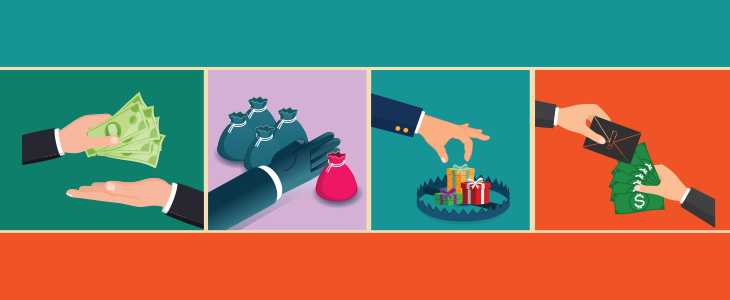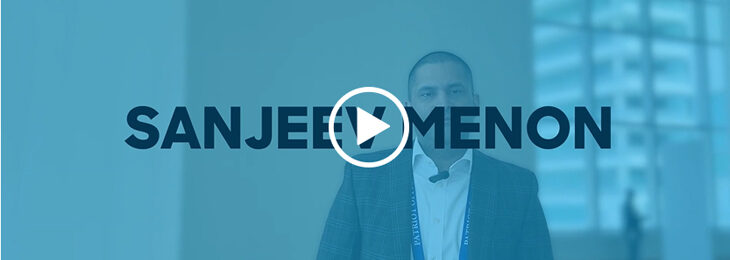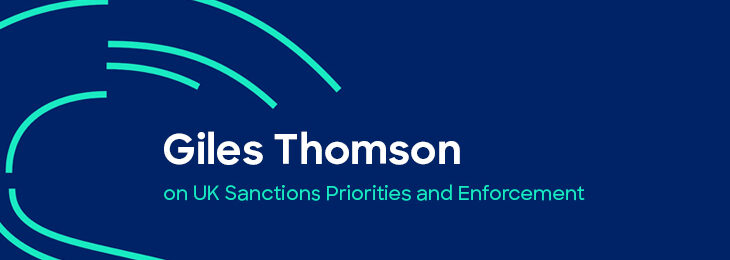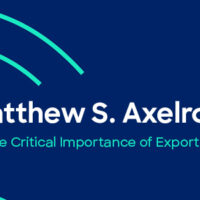
Corruption is not a recent phenomenon; it has been in existence for over 2,000 years. Corruption prevailed in many ancient kingdoms highlighted throughout history. Corruption is a much larger phenomenon that can only be observed and is subject to one’s perception of the act being committed. However, many scholars have defined corruption as intentional noncompliance within a transaction that results in an advantage being given to an individual or a group of individuals.1 Simply said, an act of corruption can occur when an individual abuses his or her entrusted power for their private gain.2
The main forms of corruption are bribery, embezzlement, fraud and extortion. However, these forms of corruption can overlap and can be regarded interchangeably with some others, such as theft, favoritism, nepotism, etc. Corruption is usually committed by someone who holds public authority, such as a state-elected official accepting a commission under the table for granting a specific state contract or an elected official commingling public funds for his or her own benefit.3 Other examples include defrauding the government through underreporting taxes or extorting money through blackmail or coercion.4
Corruption as a Crime
Public corruption is considered a federal crime. Thus, bribing a public official is considered a criminal act not only by the one receiving the bribe but also by the one offering the bribe. Furthermore, the U.S. Constitution has made bribery one of the two explicit crimes that could lead to the impeachment of a U.S. president.5 Corruption is considered a white-collar crime and, therefore, sometimes gets favorable treatment under the law as opposed to violent crimes. The perception of and the attitude toward white-collar crime are different from that of violent crime. It is often this fascinating phenomenon that white-collar crimes bring to the table that results in these types of offenses being treated differently by the public. For example, in some countries6 (mainly seen in developing countries), bribing a public official is customary to either get a routine service completed or expedite the performance of those government offices. In cases such as this, it is the battle of morals and the perception of the individual that determines the level of corruption. In some cases, embezzlement is harder to detect; thus, the perpetrators and victims are harder to identify, making it much harder to enforce the law on the perpetrators.7 Many times, violent crimes are easier to prosecute as the perpetrators and victims are clearly identified.
Corruption as a Predicate Offense for Money Laundering
By definition, corruption in any form is illegal across the globe. However, there seems to be a gap in enforcement against the perpetrators based on a nation’s legal system and political structure. Money laundering, by definition, is hiding ill-gotten funds by perpetrators. Thus, financial gains obtained through corruption get transferred via various channels, either legally through financial institutions (FIs) or illegally through various other forms of underground channels. Many times, financial gains obtained through corruption are transferred to tax haven jurisdictions to avoid detection.8 When corruption is linked to a predicate offense for money laundering, enforcing the law on perpetrators is much more effective as money laundering carries a severe penalty within the anti-money laundering (AML) and counter-terrorist financing regulations within a country. Financial or property gains obtained through corruption can be effectively traced and confiscated through international coordination when corrupted gains are laundered by perpetrators.9
Consequences of Corruption
There are significant consequences of corruption. These effects are widespread across regions and countries. Many financial and economic losses stem from direct losses not only to the individual victim(s) but also to the society as a whole. Corruption starts with one dishonest individual who creates the domino effect by adding others to his/her web of perpetrators. This can happen through onlookers’ lack of ethical and moral values and, eventually, the lack of punishment for perpetrators. The level of corruption can be direct through straightforward personal gain or through indirect, unintentional acts, such as a publicly elected official accepting a cash gift just merely by reason of his/her office. This means that the one trusted and elected to hold office does not necessarily perform a favor to the third party in consideration of the cash gift. Because of the position the public official holds, however, acceptance of the gift presents the appearance of conflict—a key factor that can be challenged later. Eventually, corruption schemes can spiral into an entire organization, linked through other organizations and then an entire country, and can even cross international borders.
Corruption manipulates incentives and general economic and market forces, eventually leading to the misallocation of resources. Most importantly, corruption reduces tax revenue for the government. These factors will ultimately artificially create some inefficiencies, such as raising production costs and causing decreases in human capital, thereby making some investments inaccurately calculate lesser profits. When an organization or country has a high rate of corruption, it creates an imbalance of economic activities. A country’s enforcement of laws on corruption, intercession and buying influence has a negative perception by national and foreign companies who seek investment in the respective countries. Thus, there would be a slowdown in the country’s economic growth.10 Average citizens or perpetrators may not see the seriousness of corruption from its face value. However, the aggregate theft of public funds through bribes, fraud, embezzlement and extortion is much more serious to a nation’s economic growth and development. This is why corruption is higher in nations that lack effective money laundering laws and enforcement strategies for perpetrators of this type of white-collar crime. Some empirical research states that a one-unit increase in corruption reduces GDP per capita by 0.15% to 1.5%.11
Challenges Enforcing the Law on Perpetrators
Enforcing the law on corrupt individuals, organizations and nations is challenging for a couple of reasons. One of the hardest issues is tracking down ill-gotten gains. This is the case with laundered money. Individuals who commit corrupt acts usually hide them to avoid detection. Many times, these are people with power, authority and political connections. Thus, they have avenues to hide corrupt proceeds, whether in the form of physical or liquid assets outside of their home country. This is where international cooperation comes into play in terms of tracking the corrupted proceeds of the money trail. Law enforcement (LE) in developed nations such as the U.S. can run into issues in enforcing the law and may be unable to recover the corrupted assets based on the international nation’s unwillingness to assist in investigations. This could be due to both countries’ lack of mutual agreements in sharing and transparency about records.
One of the major challenges occurs when certain nations do not consider corruption as a crime that is considered “criminal” and rather “civil.”12 As such, there could be lesser penalties for perpetrators who funnel corrupted money to nations that are a haven for corruption. Another challenge applies when LE hands are tied due to sovereign immunity offered to public officials that do not apply to common citizens. Sovereign immunity is a hurdle when dealing with international publicly elected officials such as heads of state and high-ranking members of governments.13 However, in March 2022, the U.S. case against former Sri Lankan Ambassador Jaliya Wickramasuriya for corruption was prosecuted successfully by bypassing diplomatic immunity.14 Even though this was a smaller case, the results prove that effective enforcement strategies are key to zero-tolerance in this battle against corruption. Using such cases might deter future perpetrators from committing similar crimes.
Drilling Down the Beneficial Ownership Fight—Anti-Money Laundering Act of 2020 (AMLA)
One of the major regulations introduced by the Financial Crimes Enforcement Network (FinCEN) within the last few years was the AMLA.15 This act is one of the most recent reforms by the U.S. that identified the gap within our system. Prior to the AMLA, it was only a requirement by FIs to identify, collect, report and verify the true beneficial owners of companies that do business with those FIs. Since the implementation of the AMLA, companies that incorporate under various names are required to disclose their true beneficial owners. This is an important step toward identifying individuals who camouflage and divert their corrupted and other ill-gotten funds behind front companies. FinCEN now has the authority to request the actual beneficial owners of these businesses and share that information with appropriate authorities. The AMLA would eventually provide the transparency that would enable the successful uncovering of the ultimate beneficial ownership challenge and unmask many individuals who have and are planning to create masked entities to cover their ill-gotten funds, such as bribes and other laundered money.
Proactive Measures in Combating Corruption
Corruption can dismantle organizations, which can eventually bring down a nation’s economy. Thus, no country is immune from corruption. That is, despite a country having the most stringent AML rules and regulations and the most effective LE, there is always an individual or a group of individuals who do not possess strong moral and ethical values. However, legal scholars have introduced proactive tactics in combating corruption.
One method that the U.S. has utilized effectively and is starting to increase usage of is the Whistleblower Protection Act (WPA).16 As the name indicates, the WPA protects individuals who report suspected behavior. Many organizations have an anonymous hotline number or a mailbox that accepts reports of suspected behavior or corrupt acts by colleagues within that organization. These are investigated by an independent party with utmost confidentiality and results are referred to LE depending on their severity. In recent years, recognition of the WPA’s potential importance has grown within public and private organizations. A sound ethical code has been recognized as a way to prevent corruption and protect public and private funds, leading toward a positive growth trajectory.
Another method that works in parallel with the WPA is utilizing accountants as gatekeepers in performing audits and identifying inconsistencies in financial statements. Since the inception of accounting as a profession, an accountant’s main role has been to be transparent, provide integrity in financial statement reporting and provide assurance of the fairness of the financial statements to the public. As such, accountants should be regarded as the first line of defense in providing guardrails against possible corruption.
Conclusion
White-collar crimes such as corruption should be regarded as equivalent to violent crimes and should carry hefty penalties. Furthermore, whenever possible, all corruption should be subject to zero-tolerance enforcement strategies to deter future acts of corruption. Corrupted funds are funneled or laundered in order to dissociate the source of funds from the perpetrator. Thus, it is essential to have strong WPA and accounting controls to capture points of entry and exit of funds whenever and wherever possible to detect suspicious transfers of assets. Subjecting perpetrators to maximum penalties and justice, as well as rewarding the whistleblowers, is key in fighting corruption. Together, we can make a difference in protecting the financial and economic costs to our society, protecting public and private funds, allocating them appropriately and maintaining price controls. 
Kishani A. Udugampola, Ph.D., CAMS-FCI, CFE, CAMLS, Federal Reserve Bank of New York (FRBNY)
Disclaimer: The views and opinions expressed here are those of the author and do not represent an official position of the FRBNY or the Federal Reserve System.
- Vito Tanzi, “Corruption Around the World: Causes, Consequences, Scope, and Cures,” International Monetary Fund, May 1998, https://www.imf.org/external/pubs/ft/wp/wp9863.pdf
- “What is Corruption,” Transparency International, https://www.transparency.org/en/what-is-corruption
- Inge Amundsen, “Corruption,” Chr. Michelsen Institute Development Studies and Human Rights, January 17, 2000, https://etico.iiep.unesco.org/sites/default/files/2018-05/corruption_definitions_and_concepts.pdf
- Ibid.
- “Federal Bribery Charges” Carmichaellegal.com, https://www.carmichaellegal.com/federal-bribery-charges
- Benjamin A. Olken and Rohini Pande, “Corruption in Developing Countries,” Annual Review of Economics, April 25, 2012, https://www.annualreviews.org/doi/10.1146/annurev-economics-080511-110917
- JM Olejarz, “Understanding White-Collar Crime,” Harvard Business Review, November 2016, https://hbr.org/2016/11/understanding-white-collar-crime
- “Predicate Crimes To Money Laundering: Bribery And Corruption,” Financial Crime Academy, https://financialcrimeacademy.org/predicate-crimes-to-money-laundering/
- “Anti-Money Laundering/Combating the Financing of Terrorism (AML/CFT),” International Monetary Fund, https://www.imf.org/external/np/leg/amlcft/eng/aml1.htm#corruption
- Paolo Mauro, “Why Worry About Corruption?” International Monetary Fund, February 1997, https://www.imf.org/external/pubs/ft/issues6/index.htm
- Eleftherios Spyromitros and Minas Panagiotidis, “The impact of corruption on economic growth in developing countries and a comparative analysis of corruption measurement indicators,” Cognet Economics & Finance, September 23, 2022, https://www.tandfonline.com/doi/ref/10.1080/23322039.2022.2129368?scroll=top&role=tab
- Sara Martins Gomes Lopes, “Non-criminal liability and obstacles in recovering proceeds of corruption in Brazil,” Stolen Asset Recovery Initiative, The World Bank and United Nations Office on Drugs and Crime, October 25, 2022, https://star.worldbank.org/blog/non-criminal-liability-and-obstacles-recovering-proceeds-corruption-brazil
- Jon Vrushi, “Immunity or Impunity? The effects of immunity provisions on national levels of control of corruption,” European Research Centre for Anti-Corruption and State-Building, Hertie School of Governance, ERCAS Working Paper No. 53, December 2018, https://www.againstcorruption.eu/wp-content/uploads/2018/12/Working-paper-53-1.pdf
- “Former Sri Lankan Ambassador Pleads Guilty to Defrauding Sri Lankan Government,” U.S. Department of Justice, April 1, 2022, https://www.justice.gov/usao-dc/pr/former-sri-lankan-ambassador-pleads-guilty-defrauding-sri-lankan-government; Scott Woodruff Lyons, “The U.S.’s Recent Enhanced Efforts to Fight Corruption by Protected Individuals,” American Society of International Law, November 9, 2022, https://www.asil.org/insights/volume/26/issue/12
- Scott Woodruff Lyons, “The U.S’s Recent Enhanced Efforts to Fight Corruption by Protected Individuals,” American Society of International Law, November 9, 2022, https://www.asil.org/insights/volume/26/issue/12
- “FAQ: Whistleblower Protection Act,” National Whistleblower Center, https://www.whistleblowers.org/faq/whistleblower-protection-act-faq/











Great. Furthermore, corruption destroys society with all the damages that comes with it.